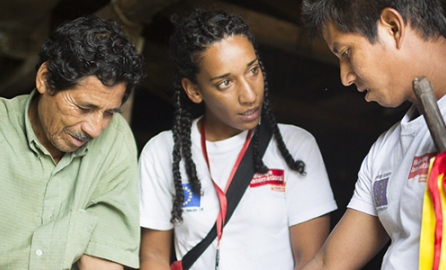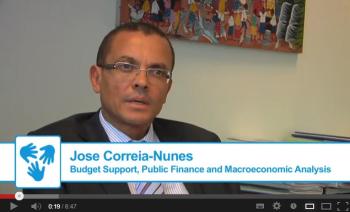About a third of the EU’s bilateral cooperation is implemented through budget support – funds provided directly to a country’s treasury to be managed using national systems, conditional on policy dialogue and performance assessment. It’s a method favoured by the European Commission for its sustainability, based on partnership, country ownership, trust and results. To strengthen these, the EU had updated and simplified its Budget Support Guidelines, taking effect from October 2017. DEVCO’s Erica Gerretsen outlines the main changes.
What is budget support?
The EU disburses €1.7 billion a year through budget support to some 90 countries and territories around the world. The guidelines which govern when and how it can be used were last updated in 2012 – and a lot has happened since then, according to Erica Gerretsen, Head of Budget Support, Public Finance Management and Domestic Revenue Mobilisation at DEVCO, the European Commission’s Directorate General for International Cooperation and Development.
These developments include the 2030 Agenda and Sustainable Development Goals; the Addis Ababa Action Agenda on financing for development; and the new European Consensus on Development adopted in June 2017 – all of which have an impact on the way the EU cooperates with partner countries.
There are also changes to EU’s other aid modalities alongside budget support – such as increased use of 'blending' (using EU funds to leverage public and private financing for investments) and EU trust funds. “The guidance introduces them as part of our new toolkit, and we need to be able to ensure good complementarity between them” said Erica Gerretsen.
“We have learned lessons from the last five years of implementation of the 2012 guidelines; we have our own experience, and we have had evaluations which showed good results on the implementation, on the use of the modality, but of course required some adaptation,” said Erica Gerretsen.
|
In Brief: When does the EU use budget support? There are four main conditions for budget support:
Budget support contracts have three components:
|
What’s changed in the 2017 Guidelines?
“There was a real need to decrease the number of pages we produce, and give more time to dialogue and content,” said Erica Gerretsen.
The new Guidelines will streamline the documentation required at the time of programme approval and simplify reporting requirements while a budget support contract is implemented.
“This means only real progress made will be appearing in the files produced by Delegations, which will give them more time for content work, to focus on results and progress made by developing and partner countries,” said Erica Gerretsen.
In terms of content changes, it has been decided to rename the three types of budget support contract to reflect the new policy context and specify their scope accordingly.
|
Budget support contracts There are three types of budget support contracts:
|
“We have also reinforced the guidance on domestic revenue mobilisation, where we identify in a more specific manner how Delegations and partner countries can have a dialogue on tax policy, the fight against illicit financial flows, and tax avoidance mechanisms,” said Erica Gerretsen.
Another area which is strengthened concerns the visibility of EU’s assistance. When EU assistance is channelled through the national government, perception surveys often find that programme beneficiaries aren’t aware of the EU’s involvement. “We believe there is scope for improving the visibility of results we gain through budget support, and that is reflected in the Guidelines,” said Erica Gerretsen.
Interaction with Other Donors & Instruments
While DEVCO continues to use budget support, many EU Member States have decreased their use of it in their own bilateral assistance. However, that isn’t to say that they can’t work together. “Even when Member States don’t do budget support any more, there is a way to include them in the tool, especially when we do Joint Programming,” said Erica Gerretsen.
“The idea is to say that we [the European Commission] have a budget support contract which has three components - policy dialogue, performance assessment and capacity development, and transfer of funds,” said Erica Gerretsen. “In those three components Member States can work with us in a powerful manner on policy dialogue, performance assessment and capacity development, and can leave to us the responsibility of the financial transfer. We can do that according to our rules and procedures, which are robust, strong, and have shown good results.”
Another avenue for collaboration with Member States is through EU trust funds, a new addition to DEVCO’s toolbox. “It’s important to see trust funds as mechanisms whereby Member States bring in funds, and we can channel those funds through budget support to partner countries.”
Erica Gerretsen also highlighted the importance of finding complementarities between budget support and blending for investment. “If we work on the energy sector in a country, it’s relevant to think of a blending operation for building the infrastructure; and at the same time to have a Sector Reform Performance Contract that will ensure the national policy of the energy sector is aligned to the needs of the country for its energy provision, its distribution on the network,” said Erica Gerretsen.
“There are clear reinforcements possible, and it’s essential to find the strengths of both instruments and bring them together in partner countries,” said Erica Gerretsen. She pointed to a test case in Tanzania where blending and budget support are being deployed together, which should become a useful first example to build on.
There is also an important role for non-EU donors such as the International Monetary Fund and the World Bank in the EU’s budget support. “They look at macroeconomic stability, which is one of the prerequisites for Budget Support, so we have extremely strong partnerships with both these institutions,” said Erica Gerretsen. “We also bring in regional donors such as the Asian Development Bank, African Development Bank and other bilateral donors on ground.”
To read the updated Guidelines, visit this page.
Training
Training on budget support is available in various formats - online via EU Learn, and in person through seminars in Brussels and in Delegations. These can provide a space for discussions between Delegations, national administrations and other donors.
For more information, contact Florence Brosset-Heckel (florence.brosset-heckel@mksp.eu)
“It is important that it’s not only the economists in Delegations who follow this training,” said Erica Gerretsen." Budget support is a tool for everyone - colleagues working on thematic sectors should also be acquainted with them. And it is also the work of Heads of Cooperation and Heads of Delegation, as they are the ones who will carry the policy and political dialogue that accompany budget support when we provide it to a partner country.”
Photo © JonasWresch/HelpAge2014






Log in with your EU Login account to post or comment on the platform.